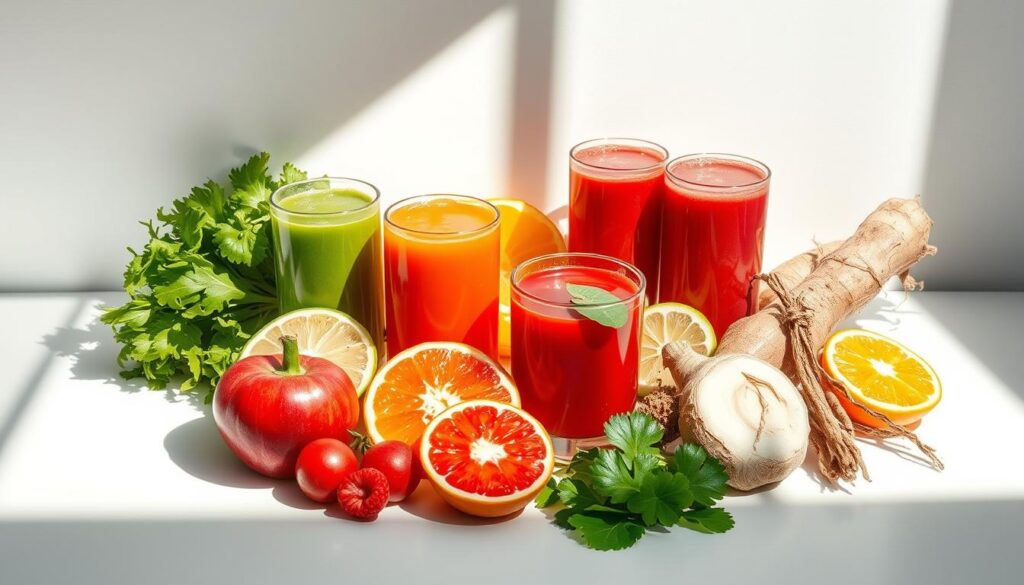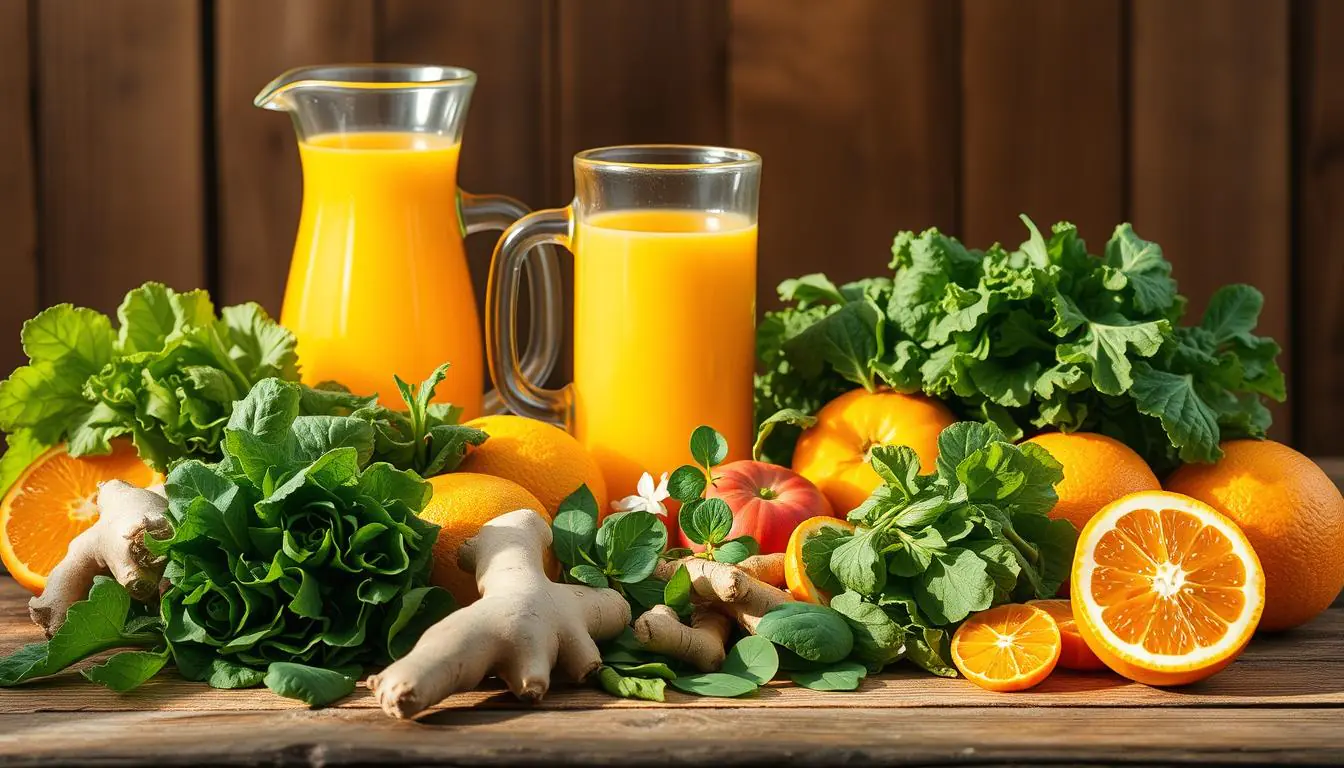Ever felt really tired after a long day? It’s not just from not sleeping well. It’s also from the hidden inflammation in your body. Talking about this is important for our health and what we eat.
Adding anti-inflammatory juices to your meals can change your life. They help clean your body and make you feel better. Imagine drinking a juice that’s full of good stuff and makes your meal even better.
Chronic inflammation can cause problems like arthritis and tiredness. Using healthy juices is a smart way to fight this. This article will show you how to use juices with antioxidants like strawberries and omega-3s from chia seeds. Let’s see how these drinks can make your meals better and help your health.
Key Takeaways
- Chronic inflammation can lead to various health issues such as arthritis and fatigue.
- Incorporating anti-inflammatory juices can promote wellness and vitality.
- Juice recipes often include antioxidant-rich ingredients that fight inflammation.
- Detox drinks can complement your meals, enhancing both nutrition and flavor.
- Healthy juicing recipes can be tailored to individual tastes and dietary needs.
- Regularly consuming anti-inflammatory juices may lead to improved energy levels and digestion.
Understanding Inflammation and Its Impact on Your Health
Inflammation is a natural response that can be harmful if it lasts too long. It helps protect us from injury and infection at first. But, if it goes on too long, it can cause big health problems like heart disease and cancer.
Knowing what causes inflammation is key to staying healthy.
What Causes Inflammation?
Many things can lead to long-term inflammation. These include our lifestyle and what we’re exposed to. Some common causes are:
- A diet full of sugar and processed foods
- Not being active enough
- Being around harmful toxins
- Stress and not getting enough sleep
Eating more whole foods can help fight inflammation. Switching to a diet full of fruits and veggies is a good start. It can help lower inflammation and improve your health.
Signs You May Have Inflammation
Knowing the signs of inflammation is important. It can help you make changes to live better. Some common signs are:
- Fatigue
- Digestive issues, like bloating or discomfort
- Skin problems like rashes or acne that won’t go away
- Joint pain and stiffness
Spotting these symptoms early can help you start an anti-inflammatory diet. This diet is full of foods that fight inflammation and make you feel better.

Benefits of Anti-Inflammatory Juices
Anti-inflammatory juices are great for your health. They help fight inflammation, which is linked to many diseases. Adding them to your diet can improve your health for a long time.
Nutritional Advantages
Juices do more than just hydrate you. They are full of vitamins and antioxidants. Turmeric and ginger, for example, have strong anti-inflammatory effects.
These nutrients help reduce inflammation. They also boost your immune system and metabolism. Key nutrients include:
- High levels of vitamin C for immune system support.
- Vitamin K and beta-carotene that contribute to overall health.
- Antioxidants, such as catechins from matcha and anthocyanins from berries, are effective in reducing inflammation.
Long-Term Health Benefits
Drinking anti-inflammatory juices regularly can greatly benefit your health. Research shows they can lower the risk of heart disease, diabetes, and arthritis. They can also improve digestion, boost energy, and enhance overall health. Key benefits include:
- Potential reduction in chronic inflammation.
- Improved weight management and metabolism.
- Lowered risk of developing serious health conditions.

Key Ingredients for Anti-Inflammatory Juices
Choosing the right ingredients for your anti-inflammatory juices is key. A good mix not only tastes great but also boosts health. Use anti-inflammatory fruits and veggies, along with herbs and spices, for a drink that’s good for you.
Fruits and Vegetables to Include
It’s important to use a variety of anti-inflammatory fruits and veggies in your juices. Here are some great options:
- Pineapple – It has bromelain, which fights inflammation and helps with digestion.
- Green Apple – It lowers blood pressure and sugar, and tastes crisp.
- Spinach – It’s full of vitamin K, which stops inflammation.
- Cucumber – It’s full of water, helping with joint health.
- Celery – It has luteolin, which reduces body inflammation.
Herbs and Spices to Boost Flavor
Adding herbs and spices can make your juice taste better and be healthier. They also add a special flavor:
- Turmeric – It’s a strong anti-inflammatory, great for arthritis.
- Ginger – It blocks pain and swelling, perfect for detox juices.
- Lemon – It’s full of antioxidants, cleaning your body and fighting toxins.
- Parsley – It’s rich in vitamin C and flavonoids, fighting oxidative stress.
- Mint – It’s refreshing and helps with digestion.
Using these ingredients makes your juices not only tasty but also good for your body. Choose organic for the best nutrients. Try these out to make your juicing better!
Delicious Juice Recipes to Try
Try these tasty juice recipes for flavor and health. They have anti-inflammatory ingredients. They’re great for your meal plan.
Turmeric Ginger Juice
This juice has turmeric and ginger. They help fight inflammation and aid digestion. You’ll need:
- 1 cup of pineapple chunks
- 1 medium green apple
- 2 cups spinach
- 1 slice of cucumber
- ⅔ stalk of celery
- ¼ medium lemon
- 1-inch piece of ginger
Juice these ingredients for health benefits. Pineapple’s bromelain is anti-inflammatory. Ginger aids digestion. It’s a refreshing drink.
Beetroot and Carrot Juice
This juice is made with beetroot and carrots. They detoxify your body. You’ll need:
- 2 medium beets, peeled and chopped
- 2 large carrots, chopped
- 1 apple for sweetness
- 1-inch piece of ginger for flavor
This juice is colorful and supports liver health. Carrots have vitamin A. Beets have antioxidants. It lowers blood pressure and detoxifies.
Pineapple Mint Juice
This juice is refreshing with pineapple and mint. You’ll need:
- 1 cup pineapple, chopped
- ½ medium cucumber, chopped
- 8-10 mint leaves
- ½ small lime or lemon
Mint cools you down, and pineapple is sweet. It’s tasty and aids digestion. It fights inflammation.
Incorporating Juices into Your Dinner Routine
Adding juices to your dinner can make meals better and healthier. Juices pair well with food, making dinners tasty and good for you. They go great with protein and salads, making your meals more fun and healthy.
Pairing Juices with Your Meal
Think about how juices can make your meals better. Juices offer many ways to mix flavors:
- Turmeric ginger juice is good with grilled chicken, adding a zesty touch.
- Beetroot and carrot juice is great with vegetable salads.
- Pineapple mint juice is nice with fish or light pasta.
These pairings not only taste good but also help with digestion and nutrient use. They’re perfect for dinner, encouraging you to try new foods and get more vitamins and minerals.
Timing: When to Drink Your Juice
The best time to drink juice varies by person and digestion. You might prefer:
- Drinking juice before dinner to get hungry for your meal.
- Having juice after dinner to help with digestion and feel better.
Juices are a big help in getting your daily fruits and veggies. Since each juice is two servings, it’s easy to meet your daily needs. Adding juices to dinner makes your meals more enjoyable and healthy.
Prepping Juices for Busy Weekdays
It can be hard to fit in healthy juices when you’re busy. But, with some smart tips, you can always have a healthy drink ready. Batch juicing lets you make many juices at once. This saves time and adds important fruits and veggies to your diet.
Using the right storage keeps your juices fresh. This way, you can enjoy them whenever you want.
Batch Preparation Tips
Start batch juicing with a mix of fruits and veggies. This way, you get different nutrients in your juices. Each recipe makes two servings, helping you meet the 4 1/2 cups of produce goal.
To make juicing easier, consider these tips:
- Choose recipes with common ingredients to save time.
- Prepare all your produce before juicing.
- Juice in big batches to save effort.
- Use a good juicer that keeps nutrients in.
Storage Solutions for Freshness
Keeping your juice fresh is key. Use airtight glass containers to stop oxidation. Here’s how to keep your juices fresh:
- Fill containers to the top to reduce air.
- Mark the containers with the date.
- Put them in the fridge right after juicing.
Customizing Your Juices
Customizing juice recipes lets you make them taste better and be healthier. Your taste should guide you in making tasty drinks that are good for you. By changing ingredients, you can make each juice just right for you.
Adjusting to Personal Taste Preferences
Start with ingredients you like when making juice. Blood oranges are sweet and good for you. Apples add a crisp taste and help fight inflammation.
Pears add a soft flavor and are good for your gut. Try mixing these fruits to find flavors you love.
Adding Superfoods for Extra Benefits
Superfoods make your juice even better. Chia seeds add omega-3s, and spirulina is full of vitamins and antioxidants. Adding them boosts your juice’s health benefits.
Mixing chia seeds with apple and ginger juice makes it more nutritious and filling. Keep trying different mixes to get the best taste and health.
Common Mistakes to Avoid
Juicing can boost your diet, but some mistakes can ruin it. Focus on the quality of your ingredients and portion sizes. This will make your juice healthier and more beneficial for you.
Overlooking Ingredient Quality
Using bad produce can lessen the juice’s health benefits. Choose fresh, organic fruits and veggies. They have more nutrients and less pesticides. Pick bright, ripe ingredients for the best taste and nutrition.
Remember, the quality of your ingredients matters. Your body needs the best fuel.
Incorrect Portion Sizes
Not knowing the right portion sizes is a big mistake. Drinking too much fruit juice can add too much sugar. This can undo the health benefits you want.
Limit your juice to one sweet fruit to control sugar. Finding the right balance makes your juice both healthy and tasty.
The Role of Juices in a Balanced Diet
Adding juices to your diet boosts your nutrient intake. They are a quick way to get important vitamins and minerals. This makes them a great addition to your meals.
While whole foods are full of fiber, juices offer concentrated nutrients. Knowing how juices and whole foods work together helps you make better food choices. This supports your health.
Complementing Your Nutrients
Juices are a fast way to get more nutrients. For example, citrus juices have a lot of vitamin C. This vitamin helps your immune system and overall health.
Tomato juice has magnesium, which fights inflammation. Leafy green juices, like kale, are full of nutrients like magnesium and vitamin A. So, juices not only hydrate you but also boost your nutrient levels.
Juices vs. Whole Foods
Both juices and whole foods have their own benefits. Whole foods give you fiber, which helps with digestion and keeps you full. Juices, on the other hand, are low in calories and full of water. They help with hydration and nutrient absorption.
Having both in your diet is a smart way to eat. Juices can help your gut health and reduce inflammation. Mixing whole foods with juices creates a balanced diet. This maximizes the good from both.
How to Measure the Effectiveness of Juices
It’s key to know how well your anti-inflammatory juicing works. Keeping a health journal for juices helps track its effects over time. This way, you can see which juices really help you feel better.
By writing down your experiences, you make smarter choices about what juices to drink. This helps meet your health needs better.
Keeping a Health Journal
Keeping a health journal for juices helps you stay consistent and aware. Write down the juices you try and how they make you feel. This helps you see how different ingredients affect your health.
By noting any changes in your symptoms, you can adjust your juicing plan. This makes your juicing more effective.
Tracking Your Energy and Mood
Tracking your mood and energy is very helpful. Notice how different juices make you feel. This can show you which juices boost your mood or energy.
This info helps you make better choices and stick to an anti-inflammatory lifestyle. It’s a powerful way to improve your health.
Conclusion: Embracing Juices for Better Health
Exploring anti-inflammatory juices shows they’re more than tasty drinks. They’re key to a healthy lifestyle. Drinks like Vitamin C Anti-Inflammatory Juice and Strawberry Blueberry Juice boost your health.
Choosing fresh, organic ingredients means more nutrients in every glass. This makes each sip healthier.
Start making juice recipes that fit your diet and taste. Try new mixes like Cucumber Kiwi Juice for antioxidants and hydration. Juicing lets you explore health in a fun way.
Each new recipe can help your body in different ways. But, drink in moderation to avoid too much sugar.
Adding anti-inflammatory juices to your daily life is a serious health step. Regularly drinking them can lead to big improvements.
So, here’s to a healthier you! Enjoy finding new, tasty ways to keep your body strong.
FAQ
What are some common causes of chronic inflammation?
Chronic inflammation can come from a diet full of sugar and processed foods. It can also be caused by a lack of exercise, environmental factors, and some health issues.
How can anti-inflammatory juices aid in detoxification?
Anti-inflammatory juices help clean your body. They improve digestion and help the liver get rid of toxins. This makes your body feel cleaner.
What are the best times to drink anti-inflammatory juices?
You can drink juices before dinner to get hungry. Or after meals to help digest. It’s up to what you like best.
How do I know if the juicing recipes are effective for me?
Keep a health journal to see how juices affect you. Look at your energy, mood, and any inflammation. This helps you make changes if needed.
Can I substitute ingredients in the juice recipes?
Yes, you can change ingredients in the recipes. Just pick ones that are good for fighting inflammation.
Are there any superfoods I can add to my anti-inflammatory juices?
Yes, adding superfoods like chia seeds, spirulina, or flax seeds can make your juices better. They add more nutrients and health benefits.
How can I ensure the juices retain their nutritional value?
Keep your juices fresh by storing them in airtight glass containers in the fridge. Drink them within a few days to keep them nutritious.
What are some common mistakes to avoid when juicing?
Avoid using low-quality ingredients and not measuring right. Also, don’t drink too much fruit juice. It can give you too much sugar.
Source Links
- You Just Started an Anti-Inflammatory Diet—Here Are 23 Recipes to Make First – https://www.eatingwell.com/you-just-started-anti-inflammatory-diet-recipes-to-make-first-8770807
- For More Like this Click Here

